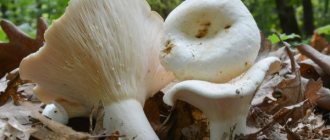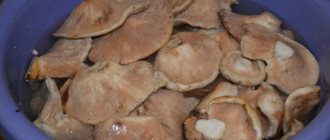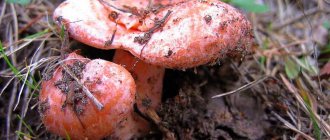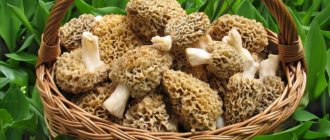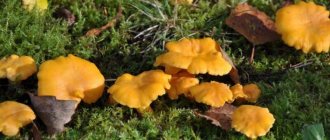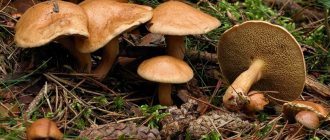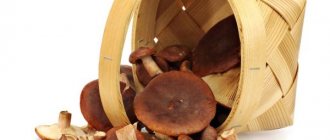Mushrooms
0
3970
Article rating
Kira Stoletova
False mushrooms are easy to find, but there are mushrooms similar to them. Among them there are edible and toxic. Eating some false milk mushrooms is fatal. White milk mushroom has a number of useful substances and, when properly prepared, has a pleasant aroma and taste.
Types of false milk mushrooms
Description of mushrooms
False milk mushroom is a welcome guest on the holiday table, but not all housewives take up the preparation, preferring more familiar types. The reason for this is the white milky juice contained in the cap and stem, which can take on a yellowish tint in the air and has a sharp-bitter taste.
Real white milk mushrooms are considered the best for pickling.
Etymology of the name
There are different versions:
- The mushroom is named so because of its large weight, at which it appears heavy and heavy.
- The origin comes from the word “heap”, which means a lot.
Both options have the right to life, since some individuals reach decent sizes, massive due to the abundance of juice in the cap.
Peculiarities
Milk mushrooms grow in clusters or paths. Having found one specimen, you can be sure that you won’t be able to go home without some loot, you just need to carefully inspect the surrounding area.
The average temperature for the growth of milk mushrooms is 7-10℃. According to old mushroom pickers, it is best to start “hunting” for this mushroom after long, but not heavy rains. To collect, you will need a stick and a sharp knife.
They choose sunny clearings as habitats and do not hide in the shade. After rain, the cap becomes slippery, like a butternut cap, and the shape is always slightly concave, funnel-shaped.
Fruit bodies contain vitamin D of non-animal origin, and are also rich in protein (up to 30%), such an amount can replace meat.
Another nice feature: the almost complete absence of pests on mushrooms, so even caps with a large diameter will not be wormy. Insects do not like the specific taste and try to stay away.
Beneficial features
Mushrooms are recommended for those who are on a diet. Eating them regularly also helps:
- replenish mineral deficiency;
- increase immunity during epidemics and when there is a threat of tuberculosis, since the composition contains substances that resist Koch's bacillus;
- stabilize the nervous system;
- improve digestion;
- activate the process of removing toxins.
All milk mushrooms, including false ones, must be soaked to remove the bitterness from the milky juice. The difference in processing time is dictated by the characteristics of a particular species.
Mushrooms similar to milk mushrooms
Mushrooms are often similar to each other, and even experienced foresters may not know all the differences. Check out several species that can easily be confused with milk mushrooms. Consider the specific descriptions and be careful when collecting in forests.
Spruce row
The mushroom prefers damp coniferous forests and begins to appear from late August to early September. The row has a very unpleasant smell and taste. Young representatives of the species look like greenflies. However, they are brown in color.
The cap has a tubercle, its structure is fleshy. The hollow leg, which is not hidden under the cap, is clearly visible. Favorite place for rowing is mossy ground. The plates are pale, as is the leg. Adult mushrooms crack.
Milky
A lamellar representative of the Russula family. Grows in forests and meadows. It is also called smoothie. The milky mushroom is almost a double of the milk mushroom. Some species appear almost identical.
Important! The gray-pink milkweed is deadly. It is easily identified by its noticeable ocher-red color.
Characteristic signs of the laticifer:
- The cap reaches 15 cm in diameter. Its shape is funnel-shaped. The color changes from brown to almost lilac or purple. The surface is slimy and smooth. The pulp is thick yellowish. The white milky juice turns slightly green in the air.
- The plates are frequent and pale cream in color. Adult mushrooms leak juice and yellow spots appear.
- The spore powder is colored light yellow.
- The hollow stem can grow up to 15 cm or remain low, lighter in color than the cap.
Volnushka white
Whitefish loves the edges of birch forests or coniferous-birch areas. From the beginning of October to the end of August, this species appears on the soil surface in large groups. The mushroom cap is from 4 to 8 cm. Its shape varies from convex to funnel-shaped. The skin is densely pubescent, white, with a dark center. Frequent and narrow plates are white.
The leg is low, up to 2 cm wide. The shape is a cylinder, tapering towards the base. The surface is slightly or completely smooth. The leg has a cavity inside. The pulp is white, rather fragile, and its smell is weak. There is a lot of milky white juice, it is very caustic, its shade remains unchanged when cut.
Toadstool
You are probably familiar with the stories about the pale grebe. We even met her in the forest. We saw its greenish tint. But sometimes this mushroom is almost white. On the surface of the caps of young representatives there are warty growths that easily disappear. The leg can be with or without scales.
Did you know? Even today, toadstool is used as a medicine, but only in homeopathy in the smallest doses. In the Middle Ages, this mushroom was used to fight cholera.
The color is white, yellow or greenish. The pleasant smell of young toadstools changes over time to a sweet and cloying one. In general, this poisonous mushroom is distinguished by a thicker base of the stem and the presence of a seal on it near the cap.
Pig
The thin pigfish is considered to be deadly poisonous. The hat of this forest representative of the Svinushkovs is rather flat than funnel-shaped, slightly depressed, gray-brown in color. There are scars on the wavy edges. The pulp is first dense, then loose. It darkens when cut.
Often the pig is wormy. The spore layer is located in pseudoplates, which are slightly lighter than the cap. The short stem is also paler than the brownish tint of the upper part of the mushroom.
Skripun
Description
All varieties of milk mushrooms need to be soaked
Outwardly, it is very similar to a real milk mushroom: the same weighty fruiting body, squat leg.
The cap is white, size from 8 to 20 cm, the plates on the inside are sparse, the shape is concave, reminiscent of a funnel.
Most often, the mushroom grows in birch groves and mixed forests, and in favorable weather it produces abundant harvests.
How is it different from milk mushrooms?
To establish the truth, it is enough to cut or break the cap and look at the color of the juice. In violin, it takes on a reddish tint after drying.
Irina Selyutina (Biologist):
In addition to changes in the color of the milky juice, the violin is characterized by the following features that distinguish it from milk mushrooms:
- the plates of the hymenophres in young specimens are yellow, and in mature ones they are much lighter in color, while in real milk mushrooms they are white with a yellowish tint;
- the leg is short and thick, tapering towards its base and covered with small fluff. This feature gave the mushroom another name - felt mushroom.
The double is also assigned edibility class 4, which means longer soaking - up to 5 days.
The harvest time comes a little earlier, already from mid-July. If you run a fingernail (knife) along the cap, or when you put fruiting bodies in a basket and they touch each other, a characteristic squeak occurs.
The mushroom is not recommended for dry storage; it can be salted or pickled.
Differences between pig and dark milk mushroom
Svinushka is considered a lamellar mushroom, growing up to 20 centimeters in diameter. Young mushrooms are “equipped” with a convex cap, which begins to straighten and later turns into a kind of funnel (as they age). The surface resembles olive-brown velvet, the flesh inside is light brown. If the fruiting body is broken, the plant quickly acquires a dark brown color.
Read also Strawberry Russian size description of variety photo reviews
The inner side of the “head” is strewn with frequent plates connected by transverse tissue from below. The leg is much longer than that of the edible milk mushroom and can grow up to 9-10 centimeters. It bears fruit regardless of the type of forest thicket and develops in large colonies. To avoid poisoning, it is recommended to visually get acquainted with the culture, at least in a photo from the Internet, since eating a poisonous fruit can lead to serious health problems or even death. Svinushka is an insidious mushroom; symptoms of poisoning may not appear immediately, but even after several months, when it is almost impossible to help the victim.
Gorchak
Description
More similar to boletus, sometimes it is confused with boletus.
It is inedible because no measures can remove the bitter, nasty taste. If at least one representative gets into the soup, the dish will be spoiled irrevocably.
The bitterness does not break down during heat treatment, but is enhanced many times over.
If a specimen was found near a rotten stump and was never bitten by anyone, despite its impressive size, then rest assured that it is a bitterling.
How is it different from milk mushrooms?
It does not look like milk mushroom at all; it is impossible to confuse it with agaric mushrooms.
Externally, it slightly matches the white one: it is also stocky, stands confidently on a strong thick leg, the inside of the cap is spongy.
You can distinguish it only by taste. It is enough to lightly lick the edge - if you feel bitterness, you should immediately rinse your mouth and throw the mushroom away.
Also pay attention to the stem on the cut: in bitterling it turns pink.
Spruce row
Description
Ryadovka grows in coniferous forests
There is still debate about its toxicity, but that it is inedible is a recognized fact.
So named for its habitat, as it prefers damp spruce and pine forests.
How is it different from milk mushrooms?
Often confused with the greenfinch, however, it is distinguished from it by its tall, hollow stem and lighter colored cap.
But it can only be confused with milk mushrooms due to inattention. The latter never grow in coniferous forests; you need to look for them near birch trees, since it is with this tree that they form a symbiosis.
Toadstool
Description
Some of the most poisonous mushrooms look quite harmless, showing off to others a white, graceful fruiting body and a thin skirt around a long stem.
The cap is round, sometimes covered with small scales. The leg is thin, the connection to it in young grebes is covered with a film. Sometimes intricate patterns appear on the surface, having a pale greenish tint.
How is it different from milk mushrooms?
Most of all, the toadstool resembles a wild champignon, but sometimes it is mistaken for a milk mushroom.
The main difference is considered to be a kind of volumetric ring at the base of the leg, similar to a cup. Edible mushrooms do not have such an addition.
Another sign is the shape and pale (almost green) color of the cap, a light fruiting body, as well as the habit of growing alone or in a very dense group, literally crushing its neighbors.
Blue-tailed white-necked
Description
It belongs to the laticifers, is conditionally edible, and has an elegant appearance. It grows up to 8-15 cm; as it matures, the cap becomes concave.
How is it different from milk mushrooms?
The volnushka, like the milk mushroom, prefers open places near a birch grove. Milky juice protrudes abundantly on the cut of the stem.
They are distinguished by a thick fringe along the edges of the cap.
There is no big problem from the similarity of mushrooms: both are soaked approximately the same before cooking, used in salted and pickled form.
Common milkweed
Description
A conditionally edible mushroom of the Russula family. At first glance, it resembles a milk mushroom, only with a more even cap. They have similar shades, both dark in the middle.
The hat always shines, regardless of weather conditions, and concentric circles are clearly visible on it.
The leg is hollow, gray or brown in color. The pulp is white; when damaged, it secretes a milky juice, which, as it dries, acquires an olive-brown hue.
False mushrooms are easy to find, but there are mushrooms similar to them. Among them there are edible and toxic. Eating some false milk mushrooms is fatal. White milk mushroom has a number of useful substances and, when properly prepared, has a pleasant aroma and taste.
Types of false milk mushrooms
Features of milk mushrooms
A false breast from a real one is determined based on external qualities:
- round cap with a compressed center up to 20 cm, always moist, slimy;
- the shape of the cap is funnel-shaped;
- color white, yellowish;
- brown spots are present;
- the plates are white or yellowish. The quality and age of the mushroom are determined by the plates;
- the flesh is white, elastic and fleshy;
- pungency in taste and smell;
- there is a lot of milky juice, it is absent only in the dry mushroom.
The false breast differs from the real one in appearance
Are there false milk mushrooms, poisonous, what do they look like, how to distinguish them from real ones?
Among the large assortment of edible types of mushrooms, milk mushrooms are given one of the first places. There is no mushroom picker who can bypass this mushroom, since it is distinguished by its rather bright and nutritious taste.
It’s a shame, but you can often find false squeaky mushrooms, which have a number of distinctive features. In addition, the papillary milk mushroom may end up in the basket. It can cause quite serious poisoning.
False breast
If you want to understand what exactly this mushroom looks like, you need to see a real one in person. You also need to get acquainted with the main distinguishing features and compare these features with the appearance of false mushrooms.
- The initial appearance of the cap of an edible mushroom is this: the cap is convex and has curled edges. Over time, the cap takes on a different shape. Its edges rise, creating a funnel shape in the central part.
- The cap of the edible mushroom is moist and quite dense. May have a white or cream color. As a rule, it is covered with twigs, dirt, and mucus.
- The plates of the edible mushroom are white, with yellow edges. The edges themselves are wide or quite loose. If you take a false mushroom, then it has dense, hard and thick plates that look unnatural. Often, it is thanks to the plates that one can distinguish a real milk mushroom from a poisonous one.
- Real milk mushrooms have a large amount of milky juice.
- The edible mushroom has only white flesh.
Milk mushroom is a mushroom that has a large number of false twins. But many of these mushrooms are considered conditionally edible, since according to certain characteristics they are similar to real ones.
Differences from other mushrooms
According to the description, there are many false varieties of real milk mushrooms. Many of them are eaten, but some are poisonous.
Difference from a creaker
It is difficult even for an experienced specialist to distinguish a white milk mushroom from a squeaky one.
Skripun is edible, similar to white milk mushroom, but the taste is different. It also has beneficial properties. Main differences:
- it is called creaking because of the special creaking sound when parts of the fruiting bodies come into contact;
- these false doubles appear later than the real ones;
- worms settle only in white milk mushrooms; they do not grow in the flesh of the squeaky mushroom;
- the plates are less fleshy, lighter and thinner in white.
Difference from dry milk mushrooms
False black milk mushroom is popularly called “nigella”, “dry” or “chameleon”.
It has a different cap color depending on the age of the mushroom. Initially it is white, but over time it turns brown. There is no milky juice. Features of dry milk mushroom:
- needs a well-lit place;
- lives in mixed and birch forests;
- the cap is dry;
- the hole at the top is deeper.
Difference from bitterling, or pepper milk mushroom
The white milk mushroom differs from the false milk mushroom in its place of growth. Gorchak is found in the North in forests. Grows in well-moistened places in large groups.
Irina Selyutina (Biologist):
The pepper milk mushroom is characterized by a creamy white dry cap in the shape of a funnel, as well as an abundant secretion of white milky juice, which turns bluish or olive-green in air and a specific, very hot peppery taste that disappears only after thorough soaking.
The cap is up to 8 cm in diameter. The surface is flat, convex in young organisms, and funnel-shaped in mature ones. The plates are pale, yellow and red, with a coating. The stem is up to 8 cm. The milky juice is bitter. The taste is pungent and bitter, which is why this mushroom is only salted. It is classified as conditionally edible.
Difference from thin pig
The thin pig is a poisonous species, poisoning with it leads to death. Symptoms appear several hours after eating this mushroom.
The difference between a real mushroom and a pig in a hat, which has its own characteristics:
- size – up to 20 cm;
- the edges are directed inward;
- covered with fine hairs;
- color olive, brown, yellow.
Irina Selyutina (Biologist):
Upon careful examination of the underside of the cap of the thin pigtail, or rather the hymenophore, you will notice that it is folded and not lamellar, although it is often described in various sources as lamellar. It is formed not by real, but by pseudoplates. It is easy to separate from the surface of the cap, which is not possible with real plates. The color of the pseudoplates is usually lighter than the color of the cap. When subjected to mechanical action - pressure - they darken.
The flesh of the pig is brown; it darkens at the cut site. The leg is up to 9 cm, directed to the side. Tapers towards the soil. Collection takes place from mid-summer to mid-autumn.
The false milk mushroom is larger and has a brown stem. It accumulates a large amount of heavy metals.
There are false varieties of real milk mushrooms
Inedible milk mushrooms
It is important to distinguish between edible and false milk mushrooms. Knowledge of information about the characteristics of dangerous mushrooms will protect you from adverse consequences. However, even the species listed below cannot be clearly defined as poisonous. But you should be able to distinguish them from the rest.
Bitter
Bitterweed, or bitterweed, is found mostly in northern forest zones in large groups and loves moisture. It looks like a white milk mushroom. It is not difficult to recognize bitterling.
Features:
- a cap typical of milk mushrooms, with a tubercle in the center up to 8 cm in diameter, it is silky and dry, of a brick color;
- the plates are pale - reddish-yellowish, can be descending or adherent, have a white coating from spores;
- the leg below is solid, in an adult mushroom it is hollow, evenly cylindrical in shape, up to 8 cm long, with a white base, light brick;
- the pulp does not have a strong odor, it has a dense structure, and the color ranges from white to red-brown;
- The milky juice is caustic, bitter, and white.
Mushroom picking
Each type of mushroom has characteristics regarding its place of growth, soil, light and humidity. The mushroom grows:
- in the forest of middle age. In the young they do not yet have time to appear, but in the old they are overgrown;
- the grass near the trees should be low, in high places the harvest is less common;
- collected after rain, in the morning when there is dew;
- In places where it grows, a characteristic mushroom smell is felt.
Deadlines for collecting milk mushrooms:
- black is harvested in mid-summer and early autumn;
- the blue one gathers throughout August;
- oak and aspen are harvested from the end of July until the beginning of autumn;
- yellow and pepper are harvested from July until the end of summer.
All terms are conditional. The climate and soil must be moist when harvesting.
Surprisingly, white milk mushrooms in Rus' used to be valued higher than other mushrooms. Moreover, only they were collected, completely ignoring other representatives of the mushroom kingdom. In Europe, on the contrary, they were and are still recognized by mushroom pickers as false, absolutely inedible, so they were almost never taken.
Collection and procurement rules
There are about 20 species of milk mushrooms; they are found in abundance in Siberia and the Urals, in the Volga region. They prefer moist sandy soil, slightly raised and well-lit areas. Every mushroom picker knows how milk mushrooms grow in these places. After all, a strong and tasty mushroom is a real find for a gourmet! Only young mushrooms are suitable for food, the cap of which has not reached 8-10 cm in diameter. They are prepared in different ways - boiled, salted, pickled. Different types of milk mushrooms are combined with each other, so they can be pickled together.
There is no need to be afraid of collecting black milk mushrooms, since they have no poisonous counterparts.
The collected mushrooms are sorted and cleaned of leaves and branches. Then they are thoroughly washed in a basin until the water runs clear. To remove bitterness, they must be soaked. Nigella needs to be soaked longer than other types. The optimal soaking period is 4-5 days; the water should be changed twice a day. To finally get rid of the bitterness, soaked mushrooms are boiled for an hour in two waters.
You need to soak the milk mushrooms by placing them under pressure. Then all the mushrooms will be under water and will not spoil the taste of homemade pickling.
Black milk mushrooms are ideal for canning. They are salted cold or hot, most often whole or just the caps. If there are a lot of mushrooms collected, then they are prepared in a barrel the old fashioned way, that is, they are laid in layers and sprinkled with salt. When finished, they acquire a rich purple hue. Black milk mushroom has a crispy and piquant taste, it is suitable for preparing various appetizers and salads, solyanka. When eaten on their own, it is best to serve them with onions and fragrant sunflower oil.
What does a truly royal mushroom look like?
A real milk mushroom has a milky white or yellowish cap. In young fruiting bodies it is flat, and as it grows it takes on the shape of a funnel. Its edges are tightly rolled inward and decorated with a small fringe. The thick leg is hollow inside. The pulp is white, with a fruity aroma. The milky sap is very caustic and turns yellowish when exposed to air.
This milk mushroom prefers proximity to a birch tree. Grows in deciduous and mixed forests. Milk mushrooms are collected from July to September.
In Europe it is considered false, inedible due to its bitterness, while in Russia it is exceptionally good for pickling. In the old days it was called the “king of mushrooms.” From time immemorial, during Lent it was considered a real table decoration.
Milk mushrooms are very difficult to find. They hide under leaves, but always grow in large groups. Therefore, mushroom pickers who are lucky enough to find them never leave with an empty basket. On the contrary, they begin to look for containers where else they can put the milk mushrooms. And they try to remember the places where this amazing and not false mushroom grows.
Are there false milk mushrooms?
The answer is quite simple. False milk mushrooms do not exist. There are no poisonous species among this genus. In mushroom reference books published in the West and Europe, milk mushrooms are listed as inedible mushrooms. But experienced mushroom pickers say that you just need to know how to prepare them correctly. Of course, they cannot be considered absolutely safe, since among them there are species that have a very hot taste. Such mushrooms, if not properly cooked, can cause vomiting and diarrhea. That is why all milk mushrooms must be soaked for at least a day before cooking, often changing the water, and only then salted. All other dishes are recommended to be prepared exclusively from salted mushrooms. It should be borne in mind that old specimens are very difficult to process and persistently retain bitterness. Because of this, you won’t be able to cook them tasty, which means you shouldn’t take them at all.
But there are still types of milk mushrooms that need to be treated with special attention when collecting and preparing. These are camphor milk mushrooms, pepper milk mushrooms and violin milk mushrooms. Unlike other milk mushrooms, their taste is too hot and their flesh is tougher. But they should not be considered false. They just need the most careful preparation for processing and cooking.
The benefits and harms of milk mushrooms
Due to their beneficial properties, milk mushrooms are used to treat various diseases:
- Prevention of atherosclerosis and diseases of the nervous system.
- For urinary and cholelithiasis, kidney failure, take an extract from milk mushrooms.
- In pharmaceuticals, pepper milk is used to extract lactariovialin, which is used for tuberculosis and emphysema.
- Milk mushrooms are often used in pharmaceutical preparations, because they are a true natural antibiotic.
- It is recommended that people with diabetes consume mushrooms because they help regulate sugar levels, increase glucose levels and reduce bad cholesterol.
- They help reduce neuroses and provide the body with beneficial bacteria.
- Salted mushrooms, due to fermentation, acquire protein, which has an anti-inflammatory and anti-sclerotic effect.
By eating 200-250 g of milk mushrooms regularly, three times a week, the body will be saturated with useful substances, strengthened, and cleansed of toxins.
These mushrooms will help improve the condition of your nails, hair and skin. Milk mushroom compresses are used to remove warts. The amino acids in the composition are in an easily digestible form.
Contains the following necessary for the body:
- Vitamins: A, C, E, PP, D, B1, B2 and B
- Minerals: magnesium, sodium, calcium, potassium and phosphorus.
- There are 33 g of protein per 100 g of dried mushrooms. This allows you to even replace meat with them. Vegetarians often include mushrooms in their diet.
- Salted mushrooms contain 2 times more calories than beef and 3 times more than natural farm milk. Boiled mushrooms contain only 16-26 kcal.
How to cook milk mushrooms correctly?
Preparation for pickling for milk mushrooms lasts a little longer than for other mushrooms. Without delaying the process, they need to be sorted and cleaned immediately. After that, rinse it well several times in cold water, trying to remove all the sand as much as possible (otherwise it will subsequently grate unpleasantly on your teeth). Now you can start soaking. This stage lasts from one to three days. The water should be changed at least three times a day. And only then can you pickle the mushrooms. Some people recommend boiling them for ten minutes before doing this, but experienced mushroom pickers note that in such cases the real taste and aroma of the mushroom will be lost.
Cooking white milk mushrooms and other types of these mushrooms is simple. You need to take 40 g of salt for every kilogram. Place them in containers (preferably wooden tubs) with their caps up, sprinkling them in layers with salt. If desired, you can add cherry, currant, oak leaves, garlic cloves and pepper. However, it is worth remembering that the sharp aroma of herbs and spices interrupts the true smell of mushrooms. After the container is filled, it is removed to a cool place and placed under pressure.
Salting milk mushrooms should last at least 30-40 days (or even two months) - this is the time required for complete fermentation. And only then can they be eaten. Although some mushroom pickers believe that only one or two weeks is enough. But it’s still not worth risking your health.
How to distinguish a white milk mushroom from a toadstool?
The white milk mushroom does not have a thickening in the form of a tuber, which is located at the bottom of the toadstool's stem. The toadstool itself is considered a rather dangerous mushroom. Basically, its appearance resembles that of russula.
Toadstool
The grebe has a green cap, in some cases almost white. There is a ring on the stem of the mushroom near the cap. If you do not want to confuse this mushroom with white milk mushroom, remember the following rule: mushrooms that are intended for pickling have a hole on the stem. This indicates that this or that mushroom is considered edible.
How to process milk mushrooms after harvesting?
You need to know that each mushroom tends to deteriorate quickly, therefore, they need to be washed and cleaned as quickly as possible.
- To begin, wipe the mushroom with a dry piece of cloth.
- Then remove dark places from it and clean the leg from dirt.
- If the mushroom is very dirty or wormy, then it must be placed in cool, salty water.
- After soaking the mushroom, you can cook it.
Mushroom poisoning: what to do?
The first symptoms of poisoning by false mushrooms are always similar to each other. After a few hours, a person begins to feel weakness and pain in the abdomen, he begins to feel sick, after which vomiting and loose stools appear. So the body tries to get rid of toxins in every way available to it. If help is not given at this stage, the condition may worsen to the point of dehydration.
First aid for poisoning with false mushrooms is gastric lavage. It is necessary to force the person to drink water or a weak solution of manganese, and then induce vomiting by pressing on the root of the tongue. The procedure should be repeated several times.
As soon as the nausea and vomiting pass, you can begin rehydration - restoring lost fluid. Sweet warm tea or pharmaceutical preparations, for example, Regidron, will help here. Drinking during this period should be plentiful. In addition, a person needs warmth and peace.
If you are poisoned by false mushrooms, you should not refuse qualified medical care. Even if everything was done correctly, consulting a specialist never hurts. You need to treat your health responsibly, and not rely on the usual and familiar “maybe”...
